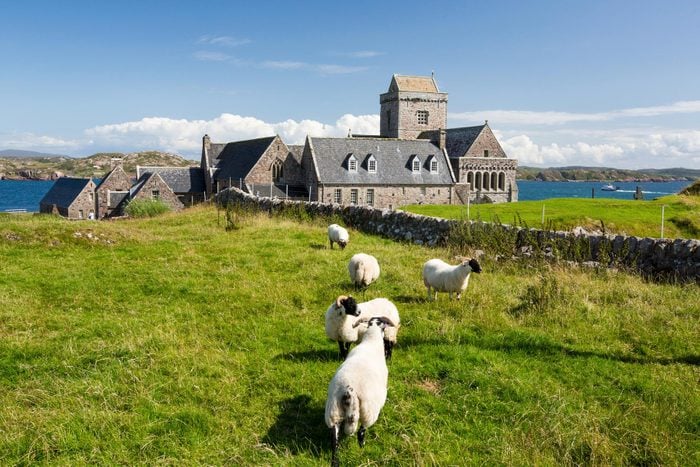The Best Time to Visit Scotland for Better Weather and Stargazing
Updated: Mar. 12, 2024

From island-hopping and hiking to stargazing and Northern Lights hunting, here's info on the best time to visit Scotland, depending on what you want to do
The best time to visit Scotland is right now. Seriously. No matter the month, no matter the year, Scotland is calling, and you should answer.
This past June and July, I was lucky enough to spend an entire month in Scotland. I cruised around its remote islands, hiked 96 miles through the rugged Highlands, visited countless historical sites and castles, and explored large and small cities by foot, bicycle and tram. Scotland immediately became one of my favorite countries in the world, and I’m already planning my return.
While some travelers add a short trip to Scotland onto a larger trip to London (which is quite easy to do), doing so means you’ll only see the tip of the proverbial Scottish iceberg. There is so much to see, do, eat and drink here that Scotland definitely deserves its own visit. Though Scotland is about the size of South Carolina, you’d think it’s as large as Alaska when it comes to its varied geography. From farm-flung islands surrounded by sea stacks to castles perched atop dramatic cliffs to rugged mountain wilderness and modern metropolis cities, you’ll find a bit of everything.
So stop drooling over those wanderlust-inducing photos of Scotland and plan a trip so you can see all those sights in person. Whether you’re hunting for cheap places to travel while visiting the UK or plan to splurge on a fancy castle stay, we have information on the best time to visit Scotland, what to know before you go and how to plan your trip.
Get Reader’s Digest’s Read Up newsletter for more travel tips, humor, cleaning, tech and fun facts all week long.
What are the best months to go to Scotland?
Technically, there is no best time of year to visit Scotland because “the best” time depends entirely on what you want to do. Do you want to attend festivals and concerts? Shop at the Christmas market? Explore castles and historical ruins? Stargaze? Marvel at the Northern Lights? There is something amazing to do every month, so your goals will determine the best time to visit Scotland.
Because I wanted to take a small-ship cruise to hard-to-reach Scottish islands and hike the world-famous West Highland Way, I visited during late June and early July. (I highly recommend Adventure Canada’s Scotland Slowly cruise and Wilderness Scotland’s trek.)
Scotland receives the most visitors between July and September, which offer warm weather and lots of activities. Keep in mind that different parts of the country receive different amounts of tourists, so no matter when you visit far-flung places like the Shetland Islands, you’ll encounter fewer people than you’ll find in Edinburgh.
And speaking of that famous Scottish city, Edinburgh is especially popular in late July and August because it hosts many popular music, theater, food and cultural festivals. Prices will be higher, and the crowds will be thicker (this year’s Edinburgh Festival Fringe sold more than a million tickets). But the entertainment options are endless.
If you’d rather avoid crowds, skip the summer. And there’s another good reason to do that: You’ll have the best chance of avoiding the notorious Scottish midge, a teensy two-winged fly that’ll swarm you and make you wish you’d brought a netted hat. Peak midge season occurs from mid-May to September, and the swarms are worse at dusk and dawn.
What time of year is the cheapest to visit Scotland?
If saving money matters most to you, the best time of year to visit Scotland is between January and March. Because relatively few visitors plan their trips during these months, this tends to be the best time to book a flight to the country. To save even more money, consider the best time to book a hotel room to get the most for your money.
The shoulder seasons are April to May and October to December. That said, Scotland is well known for its Christmas markets and New Year celebrations, so to avoid higher prices, plan your trip before mid-December or wait until mid-January.
What are the rainy months in Scotland?
The short answer is that every month is a rainy month in Scotland. After all, Scotland is part of the UK, which is famous for its gray skies, fog and rain. For many travelers, the best time to visit Scotland is during its drier summer months. In general, January is the rainiest month (averaging 19 days of rain), with October and November close behind (averaging 18 rainy days). Compare that with April through June, which averages 13 days of rain.
But the weather is never predictable, so you can end up with sunshine or rain any time of year. I encountered nonstop sunshine and unseasonably high temperatures during the first 12 days of my trip to Scotland.
Keep in mind that despite the rain, there are plenty of things to do in Scotland every month, and the rain is often brief. Western Scotland is wetter than Eastern Scotland, and while I saw more days of sustained rain in the Highlands, most of the showers I encountered in Edinburgh and Glasgow lasted fewer than 10 minutes.
I noticed that many locals carried umbrellas with them, which they put to use on outdoor patios while continuing to enjoy their beer, coffee and food. Most hotels I stayed in provided umbrellas, but you might as well add the item to your vacation packing list. As for me, I brought a waterproof jacket and shoes, which is what I typically relied on.
When can you see the Northern Lights in Scotland?

Fancy seeing one of the seven natural wonders of the world while you’re in the country? You’re in luck.
Northern Scotland lies at the same latitude as Stavanger, Norway, and Nunivak Island, Alaska, meaning you’ll have a good chance of spotting the Northern Lights if you visit. The best time to visit Scotland to catch the Northern Lights would be between November and February, which have the longest periods of darkness and the highest frequency of clear nights—both of which are required. That said, because part of Scotland is so far north, you can get some good views starting in late September.
Though it’s possible to occasionally catch the aurora borealis in the capital city, Edinburgh, your best chance of viewing the Northern Lights in Scotland will be in more remote and wilderness regions.
Stargazing in Scotland is excellent, as the country has some of Europe’s largest expanses of dark sky and is home to Europe’s second Dark Sky Park. It’s also home to many Dark Sky Discovery Sites, which experience low or practically nonexistent levels of light pollution, leaving ink-black skies filled with dazzling stars.
The Isle of Skye and its northerly Trotternish Peninsula have a whopping nine Dark Sky Discovery Sites, making this one of the best places in Scotland for stargazing and seeing the Northern Lights.
How many days are enough to visit Scotland?
The further you travel and the more regions you want to visit, the longer you’ll want your trip to be. I flew directly from New York City to Edinburgh, which is only a seven-hour flight, so I got off the plane, took a bus to Glasgow and spent several hours walking around the city before crashing and sleeping off my jet lag.
If you’re traveling on a plane from Los Angeles or Seattle, however, you’ll be looking at 13 to 15 hours of flight time. Not only do you have farther to fly from the West Coast, but you also have to factor in the time it takes for layovers, which can be even longer if you stop in another country and have to go through customs.
In 2022, the average visitor spent 9.2 days in Scotland, a respectable amount of time for a trip but still only enough time to see a very small slice of the country. I may be biased, since Scotland is one of my favorite countries, but I spent a month here, and it was nowhere near enough time. When planning your trip to Scotland, remember that though it is a relatively small country, it is extraordinarily diverse in terms of geography, sites and attractions, so this is not somewhere to rush through.
Getting around Scotland
Once you’ve determined the best time to visit Scotland based on your interests and trip goals, it’s time to start planning your vacation. The first thing to know is that it’s extremely easy to get around the country and view all its hidden gems, so don’t be afraid to stray away from the largest cities and most popular attractions.
Affordable bus, train and ferry options can move you around within and between cities and across the entire country. They are typically much cheaper, more accessible and easier to understand and use than public transportation options in the United States.
Traveling by rail
Scotland’s railway, ScotRail, is one of the best ways to get around the country, as it’s fast, safe, clean and affordable, and it connects large cities and tiny towns alike. It travels to popular places like Inverness, Edinburgh, Glasgow and Fort William, where you can catch the Jacobite steam train that crosses the Glenfinnan viaduct (made famous by the Harry Potter films). To give you an example of how affordable this is if you’re traveling on a budget: I paid about $18 for a round-trip train ticket from Edinburgh to Glasgow, and the scenic ride took about 45 minutes.
Trains accept credit cards, but you typically must purchase tickets from the station’s ticketing machines (or information desk) before boarding to avoid a fee. While you can purchase train tickets in advance, you can also buy them when you arrive at the station. For instance, I had a pre-booked ticket for my 2.5-hour train ride from Edinburgh to Inverness, but I also purchased train tickets on the spot in Edinburgh and Glasgow.
Traveling by bus
Buses are another great option and, like trains, you can pay using your credit card. (Pro tip: Get a credit card with travel rewards and save even more.) The main difference is that you typically pay for trains before boarding (otherwise, you may incur a fee), while with buses, you pay after boarding.
In Inverness, I popped into the centrally located bus station. I learned that I could take a public bus to the historic Culloden Battlefield (which was only seven miles away) instead of having to sign up for a more expensive tour to take me there. The staff told me which bus to take and gave me a schedule so I knew when I could catch a bus back to downtown Inverness.
Traveling by car
Renting a car is also an option—I drove myself from Aberdeen to Glasgow, making several stops over a few days. But if you go this route, remember that the British drive on the other side of the road.
Sources:
- Visit Scotland: “Research and Insights”
- Visit Scotland: “International Tourism Performance in 2022”
- Met Office: “UK Regional Climates”
- Edinburgh Fringe: “Optimism surrounds Fringe 2023 with 1 million tickets now issued”
- Visit Inverness Lochness: “The Highland Midge”



